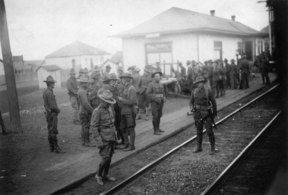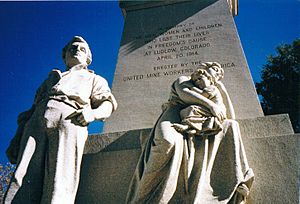Colorado Coalfield War facts for kids
Quick facts for kids Colorado Coalfield War |
|||
|---|---|---|---|
| Part of the Coal Wars | |||
|
Clockwise from top left:
|
|||
| Date | First stage: September 23, 1913 – April 20, 1914 Ten Days War: April 20, 1914 – April 30, 1914 Final stage: April 29, 1914 – December 1914 |
||
| Location | |||
| Resulted in | Strike failed
|
||
| Parties to the civil conflict | |||
|
|||
| Lead figures | |||
|
|||
| Number | |||
|
|||
| Casualties | |||
|
|||
| Total deaths, including Ludlow Massacre: 69 – 199 | |||
The Colorado Coalfield War was a major conflict in Colorado between September 1913 and December 1914. It involved coal miners who were on strike. The miners were upset about dangerous work conditions and low pay. The United Mine Workers of America (UMWA) union helped organize the strike. They were striking against companies like Colorado Fuel and Iron (CF&I), which was owned by John D. Rockefeller Jr..
The conflict happened mostly in southern Colorado. This area included towns like Trinidad and Walsenburg. Both the striking miners and people hired by the companies attacked each other. This war is known as one of the most violent labor disputes in American history.
Key Events of the War
The biggest event of the war was the Ludlow Massacre. This happened on April 20, 1914. About 1,200 striking miners and their families lived in a tent city near Ludlow. The Colorado National Guard attacked this tent city.
The Ten Days War
After the Ludlow Massacre, the miners fought back. For ten days, they attacked many mines and other company properties. They also fought with the National Guard. This fighting spread across a large area, from Trinidad to Louisville.
The violence mostly stopped when federal soldiers arrived in late April 1914. However, the strike itself did not end until December 1914. The miners did not get what they wanted from the companies. It's estimated that between 69 and 199 people died during the entire conflict.
Lasting Impact
The Colorado Coalfield War had a big impact on labor history. It showed the struggles workers faced to get better conditions.
Songs and Books
The events of the war inspired many artists. Frank Hayes, who later became UMWA President, wrote a song called "We're Coming, Colorado." It was a tribute to the striking miners.
The famous folk musician Woody Guthrie also wrote a song. His song, "Ludlow Massacre," came out in 1944.
Upton Sinclair, a well-known author, wrote two books about the conflict. His novel King Coal (1917) was set during the war. He also wrote The Coal War, which was published much later in 1974.
The Ludlow Monument
The UMWA bought the land where the Ludlow tent city once stood. They built the Ludlow Monument there. It was dedicated in 1918. For many years, only a small sign marked the site.
In the 1990s, a government highway sign was put up. This helped more people find the monument. In 2003, the monument was damaged by vandals. It was repaired, and a celebration happened on June 5, 2005. The Ludlow Monument became a National Historic Landmark on June 28, 2009.
In 2013, Colorado Governor John Hickenlooper created a special group. This group planned for the 100th anniversary of the Ludlow Massacre. A special religious service was held at the monument on April 20, 2014.







